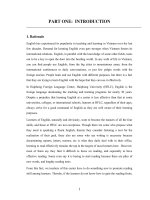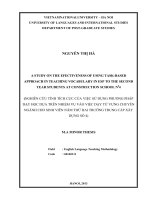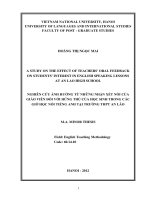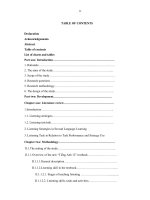DSpace at VNU: A STUDY ON THE APPLICATION OF WRITING PORTFOLIO TECHNIQUE TO SECOND YEAR ENGLISH MAJORS: AN ACTION RESEARCH PROJECT AT HANOI COLLEGE OF COMMERCE AND TOURISM
Bạn đang xem bản rút gọn của tài liệu. Xem và tải ngay bản đầy đủ của tài liệu tại đây (188.49 KB, 11 trang )
VIET NAM NATIONAL UNIVERSITY-HA NOI
UNIVERSITY OF LANGUAGE & INTERNATIONAL STUDIES
FACULTY OF POST – GRADUATE STUDIES
*****************
ĐINH THỊ NHUNG
A STUDY ON THE APPLICATION OF WRITING
PORTFOLIO TECHNIQUE TO SECOND YEAR ENGLISH
MAJORS: AN ACTION RESEARCH PROJECT AT HANOI
COLLEGE OF COMMERCE AND TOURISM
Nghiên cứu về việc sử dụng hồ sơ bài làm trong môn viết đối với
sinh viên chuyên ngành tiếng Anh năm thứ hai: Nghiên cứu
hành động tại trường cao đẳng thương mại và du lịch Hà nội
M.A MINOR PROGRAMME THESIS
Field: English Teaching Methodology
Code: 60140111
Hanoi - 2016
VIET NAM NATIONAL UNIVERSITY-HA NOI
UNIVERSITY OF LANGUAGE & INTERNATIONAL STUDIES
FACULTY OF POST – GRADUATE STUDIES
*****************
ĐINH THỊ NHUNG
A STUDY ON THE APPLICATION OF WRITING
PORTFOLIO TECHNIQUE TO SECOND YEAR ENGLISH
MAJORS: AN ACTION RESEARCH PROJECT AT HANOI
COLLEGE OF COMMERCE AND TOURISM
Nghiên cứu về việc sử dụng hồ sơ bài làm trong môn viết đối với
sinh viên chuyên ngành tiếng Anh năm thứ hai: Nghiên cứu
hành động tại trường cao đẳng thương mại và du lịch Hà nội
M.A MINOR PROGRAMME THESIS
Field: English Teaching Methodology
Code: 60140111
Supervisor: Dr. Đỗ Tuấn Minh
Hanoi - 2016
DECLARATION
I, the author of this research, certify that this thesis is result of my own work and that I
have provided fully documented references to the work of others. The material in this
research has not been submitted for a degree to any other university or institution
Hanoi,2016
Đinh Thị Nhung
1
ACKNOWLEDGMENTS
I would like to express my most sincere gratitude and thankfulness to my supervisor,
Dr. Do Tuan Minh, for his detailed instructions from the beginning of the thesis to the
valuable comments till the end.
I would like to express my gratitude to all of my lecturers at faculty of post-graduate
studies as well, who provided me with precious knowledge and helped me gained
unforgettable experiences in pursuing my studies.
Certainly, this study would not have been completed without the participation of the
students at Hanoi College of Commerce and Tourism. I thank them for their enthusiastic
attitude in learning and participating in the study. Besides, I am deeply indebted to Ms Luu
Thi Duyen, the Dean of English Department at Hanoi College of Commerce and Tourism,
who helped and supported me all the time.
My deepest appreciation is for my husband who always supported and encouraged me
with his love so that I could finish my thesis
Without all their help, this thesis would not be completed as expected
2
ABSTRACT
This action research explores the effects of writing portfolio technique on second year
students’ writing skill and the possible challenges encountering by both teachers and
students during the application process. Students created portfolios by including all the
final drafts and rough drafts into a folder; and together with students’ submitted portfolios,
two sets of questionnaires: pre and post-portfolio questionnaires, and interviews are also
used to collect the data for the research. The findings showed that the portfolio technique
not only helped to improve students’ writing skill, especially in terms of vocabulary, and
grammar, which meet student’s demands but also changed students’ attitude to the writing
skill positively and contributed to the development of students’ other skills such as
commenting, editing, reading, internet using, and group work skill as well. However,
during the process, there happened some problems. For example, this method requires
students to give written feedbacks to each other, which is quite challenging to them.
Especially, students quite easily got demotivated by negative comments from their peers.
Or, students felt boring and tiring when having to write up to three drafts for the same
topics. Nevertheless, the benefits of this technique outweigh all and prove to be effective in
helping students learning writing.
3
PART I: INTRODUCTION
1.1 Rationale of the thesis
Nowadays, it cannot be denied that globalization is affecting every corner of the
world and that due to it most countries are experiencing changes in aspects like
economics, politics, education and culture; and in that globalised world, English is
considered a main medium of communication. Therefore, it seems obvious that if a
nation wishes catching up with others in those aspects, its government should raise
public awareness about the significance of English and motivate them to learn and
master the language.
Recognizing
this
social
trend,
Vietnamese
educational
authorities
have
implemented specific policies encouraging their citizens to learn and use English.
Now, English is a compulsory subject which is taught from primary schools to
universities and an obligatory one in Vietnamese national exams. Furthermore, various
professional courses and conferences aimed at enhancing English teachers’ teaching
skills and language competence are provided to ensure a better educational service.
Also, English teachers are required to get appropriate certificates aligned with CEFR
to be qualified for the job.
What’s more? More and more state-owned or private companies, factories or
organisations prefer and employ only labor who demonstrate their ability to use
English at work and these employees are paid much higher and easily get promotion
than others. Apparently, English is one of measures for one’s career success.
The above reasons explain why teaching and learning English is recieving much
concern from society. Scholars, educators or teachers are continuously exploring
suitable and effective teaching approaches and teaching methods to improve the
English teaching and learning quality. Especially, teachers who directly work with
students and understand their needs, their intersts, their learning styles play an
important role in helping students achieve their academic and future professional
success. Therefore, it’s the teacher’s duty to discover and solve problems which the
majority of his students have.
4
Working as a teacher at Hanoi College of Commerce and Tourism and teaching four
skills: reading, writing, speaking and listening to English majors, there has always
been a question for me that why students are not very interested in writing class and
their performance in writing tests prove disappointing results. Being aware of the
unsolved problem and of a teacher’s responsibility, I would like to investigate the
situation. That is the reason why I am going to conduct this research with the hope that
a new teaching method will benefit students, making them keen on the subject, and
improving their writing skill.
1.2 Objectives of the thesis
This research intends to investigate the possible issues happening during the application
process of writing portfolio technique and examine its effects on second-year
students’writing skill at Hanoi College of Commerce and Tourism
The specific objectives of the thesis are:
(1) To find out what the effects of portfolio on improving learners’ writing skill are.
(2) To find out what problems emerging in the application process are.
The research hopes to benefit students and teachers at Hanoi College of Commerce and
Tourism and to be useful for reference.
1.3 Research questions
The thesis is carried out in order to find out the answers to two research questions:
(1)To what extent do second year students at Hanoi College of Commerce and Tourism
improve their writing skill through the application of writing portfolio technique?
(2) What challenges may teacher and students encounter in using writing portfolio
technique?
5
REFERENCES
1. Arndt, V. (1987). Six writers in search of texts: a protocol-based study of L1 and
L2 writing. ELT journal.
2. Baki, A. & Birgin, O. (2004). Reflections of Using Computer-Based Portfolios as
an Alternative Assessement Tools: A case study. The Turkish Online Journal of
Educational Technology
3. Byrne, D. (1990) Teaching writing skills, Longman handbooks for language
teacher: Longman group, ltd.
4. Candlin, C.N & Hyland, K. (1999). Writing: Texts, Processes and Practices. New
York: Addison Wesley Long man Limited.
5. Cooper, T., & Love, T., (December 2001). Online portfolios: issues of assessment
and pedagogy. Australian Association for Research in Education conference
papers.
6. Collins, A. (1992). Portfolios in Science Education : Issues in purpose, Structure
and Authencity. Science Education , 451-463.
7. De Fina, A. (1992). Portfolio Assessement: Getting Started. New York: Scholastic
Professional Books.
8. Evan,T.D & St John, M.J. (1998).Development IN ESP- a multi-disciplinary
approach. Cambridge: Cambridge University Press.
9. Emig, J. (1983). The web of meaning. Upper montclair, NJ: Boynton/Cook
10. Freeman, R & Lewis, R. (1998). Planning and implementing assessement.
London: Kogan page.
11. Furneaux, C. (1998). Process writing. In K. Johnson & H. Johnson (Eds.),
Encyclopedic Dictionary of Applied Linguistics: Oxford press
12. Grace & Cathy (1992). The portfolio and its use: Developmentally
appropriate assessment of young children. ERIC Digest.
13. Hamp-Lyons, L. (1991). Scoring procedures for ESL contexts: Assessing
second language writing in academic contexts. Norwood, NJ: Ablex
14. Hyland, F., Hyland K. (2001). Sugaring the pill: Praise and critisim in written
feedback. Journal of second language writing
15. Hyland, K. (2003). Second language writing. Cambridge University press
6
16. Kroll, B.(1997). Second language writing: Research insights for classroom.
Cambridge: Cambridge University Press
17. Larsen-Freeman, D., & Strom, V. (1997). The construction of language acquisition
index of development. Language learning , 123-134
18. Leki, I. (1976). Academic writing, techniques and task: New York, ST.
Martin’s press.
19. Leki, I. (2000). Academic writing: Exploring processes and strategies. Cambridge
University Press
20. Matsuda, P.K. (2003). Second language writing in the twentieth century: A situated
historical perspective. In B. Kroll (Ed.), Exploring the dynamics of second lanuage
writing. Cambridge: Cambridge university press
21. Myers, S. (1997). Teaching writing as a process and teaching sentence level syntax:
Reformulation as ESL composition feedback.
22. Nunan, D. (1991). Language teaching methodology. A textbook for teachers.
Helmel Hemstead: Prentice Hall International
23. Nunan, D. (1999). Second language teaching and learning. Boston: Heinle &
Heinle
24. ÖZTÜRK, H & ÇEÇEN,S. The Effects of Portfolio Keeping on Writing
Anxiety of EFL Students. Journal of Language and Linguistic Studies. Vol.3,
No.2, October 2007
25. Paulson, F.L, Paulson, P.R, & Meyer, C. (1991) What makes a portfolio a
portfolio? Educational leadership, 60-63.
26. Pincas, A. (1982). Teaching English Writing. London: Macmillan
27. Reid, J.M. (1993). Teaching ESL Writing. Englewood Cliffs, NJ: Prentice Hall
Regents
28. Simon, M. & Forgette-Giroux, R. (2000). Impact of a Content Selection
Framework on Portfolio Assessment at the Classroom Level. Assessment in
Education, 84- 101.
29. Sharon, S. & Michael, L (1994). A portfolio Assessment Model for ESL
retrieved 20 September 2015 from
/>
7
30. Slater, T.F. (1996). Portfolio Assessment Strategies for Grading First-year
University Physics Student in the USA. Physics Education, 82-86.
31. Winsor, P. & Ellefson, B. (1995). Professional Portfolios in Teacher Education: An
Exploration of Their Value and Potential. The teacher educator, 68-91.
32. White, R. & Arndt, V. (1991) Process Writing. Longman.
33. White, E. M. (1994). Portfolios as an assessment concept. In L. Black, D. A.
Daiker, J. Sommers, & G. Stygall (Eds.), New directions in portfolio
assessment. Portsmouth, NH: Boynton/Cook
34. William, P. Preparing your writing portfolio. Retrieved September 20, 2015
from />35. Wolfe-Quintero, K., S. Inagaki and H.-Y. Kim. 1998. Second Language
Development in Writing: Measures of Fluency, Accuracy, and Complexity.
Honolulu, HI: University of Hawai’i, Second Language Teaching and Curriculum
Center.
36. Valencia,S & Place, N. (1994). Literacy portfolios for teaching, learning and
accountability. The Bellevue Literacy Assessment Project
37. Yancey, K. B. (1998). Reflection in the writing classroom. In K. B. Yancey
(Ed.), Portfolios in the writing classroom: An introduction. Urbana, IL.
38. Zamel, V. (1983). The composing processes of advanced ESL students: six case
studies. TESOL Quarterly, 165-187.
8
I









